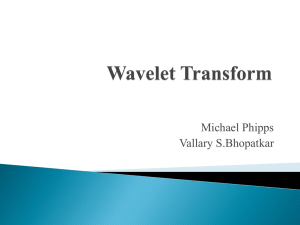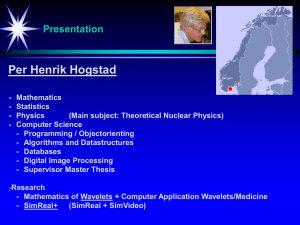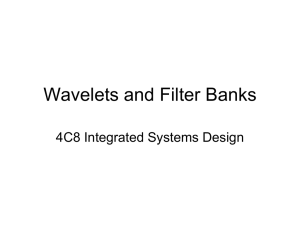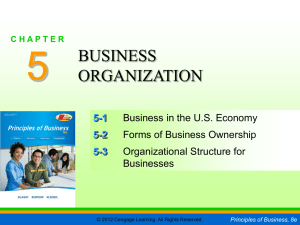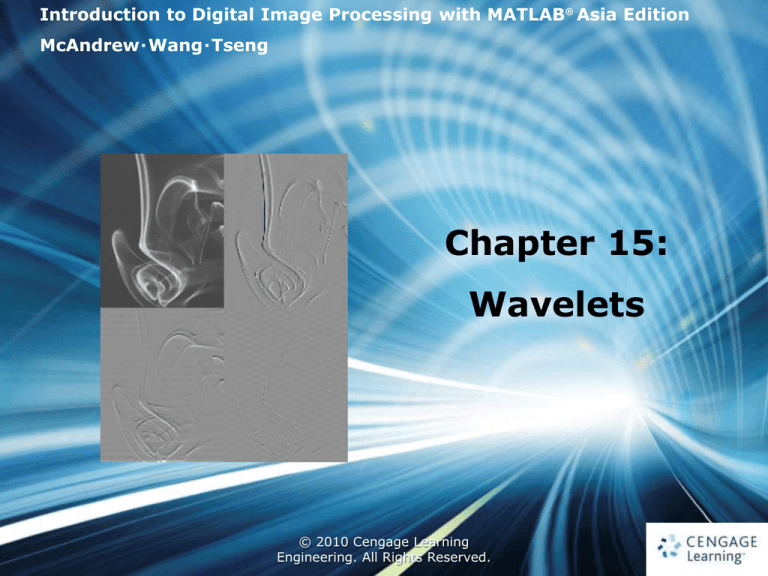
Introduction to Digital Image Processing with MATLAB® Asia Edition
McAndrew‧Wang‧Tseng
Chapter 15:
Wavelets
1
© 2010 Cengage Learning
Engineering. All Rights Reserved.
1
15.1 Waves and Wavelets
• The idea of wavelets is to keep the wave concept, but
drop the periodicity
• We may consider a wavelet to be a little part of a wave,
a wave that is only nonzero in small region
2
Ch15-p.429
© 2010 Cengage Learning
Engineering. All Rights Reserved.
15.1 Waves and Wavelets
• Suppose we are given a wavelet
Dilate it by applying a scaling factor to x: f (2x) would “squash”
the wavelet, and f (x/2) would expand it
Translate it by adding or subtracting an appropriate value from
x: f (x − 2) would shift the wavelet 2 to the right; f (x + 3) would
shift the wavelet 3 to the left
Change its height by simply multiplying the function by a
constant
3
Ch15-p.429
© 2010 Cengage Learning
Engineering. All Rights Reserved.
FIGURE 15.2
4
Ch15-p.431
© 2010 Cengage Learning
Engineering. All Rights Reserved.
FIGURE 15.2
5
Ch15-p.431
© 2010 Cengage Learning
Engineering. All Rights Reserved.
15.1 Waves and Wavelets
• 15.1.1 A simple Wavelet Transform
Wavelet transforms work by taking weighted
averages of input values and providing any other
necessary information to be able to recover the
original input
Averaging of two values and differencing
6
Ch15-p.432
© 2010 Cengage Learning
Engineering. All Rights Reserved.
15.1 Waves and Wavelets
suppose we are given two numbers, 14 and 22. We
can easily create their average
To recover the original two values from their average,
we need a second value, the difference, obtained by
subtracting the average from the first value:
7
Ch15-p.432
© 2010 Cengage Learning
Engineering. All Rights Reserved.
15.1 Waves and Wavelets
e.g.
The concatenation of v1 and v2 is the Discrete
wavelet transform at 1 scale of the original vector
8
Ch15-p.433
© 2010 Cengage Learning
Engineering. All Rights Reserved.
15.1 Waves and Wavelets
Discrete wavelet transform at 2 scales
Discrete wavelet transform at 3 scales
9
Ch15-p.433
© 2010 Cengage Learning
Engineering. All Rights Reserved.
15.1 Waves and Wavelets
To recover the original vector
At each stage, the averaging vector produces a
lower-resolution version of the original vector
10
Ch15-p.434
© 2010 Cengage Learning
Engineering. All Rights Reserved.
15.1 Waves and Wavelets
Wavelet transforms produce a mix of lower
resolutions of the input and the extra information
required for inversion
We notice that the differences may be small if the
input values are close together. This concept leads to
an idea for compression
We apply a threshold by setting to zero all values in
the transform that are less than a predetermined
value
11
Ch15-p.434
© 2010 Cengage Learning
Engineering. All Rights Reserved.
15.1 Waves and Wavelets
Threshold d3 with 0
Use d’3 to recover the original vector
12
Ch15-p.434
© 2010 Cengage Learning
Engineering. All Rights Reserved.
15.2 A simple Wavelet:
The Haar Wavelet
The Haar wavelet is defined by the function
13
Ch15-p.434
© 2010 Cengage Learning
Engineering. All Rights Reserved.
15.2 A simple Wavelet:
The Haar Wavelet
• 15.2.1 Applying the Haar Wavelet
where the subscripts on φ(x) and ψ(x) represent
different dilations and shifts of the basic functions.
Then, we can recover f(x) with
14
Ch15-p.435
© 2010 Cengage Learning
Engineering. All Rights Reserved.
15.2 A simple Wavelet:
The Haar Wavelet
The form of the equations above indicates that the
discrete wavelet transform can be written as a matrix
multiplication, as we saw for the DFT
We will show below how this is done. Notice that the
Haar wavelet can be written in terms of the simpler
pulse function:
Mother wavelet
father wavelet
15
Ch15-p.435
© 2010 Cengage Learning
Engineering. All Rights Reserved.
15.2 A simple Wavelet:
The Haar Wavelet
Dilation equation
hi are called the filter coefficients (taps)
16
Ch15-p.436
© 2010 Cengage Learning
Engineering. All Rights Reserved.
15.2 A simple Wavelet:
The Haar Wavelet
17
Ch15-p.437
© 2010 Cengage Learning
Engineering. All Rights Reserved.
15.2 A simple Wavelet:
The Haar Wavelet
18
Ch15-p.437
© 2010 Cengage Learning
Engineering. All Rights Reserved.
15.2 A simple Wavelet:
The Haar Wavelet
The averaging part of the wavelet corresponds to
low-pass filtering, in that we are coarsening or
blurring our input
Similarly, the differencing part of the transform
corresponds to a high-pass filter
Thus, a wavelet transform contains within it both
high- and low-pass filtering of our input, and we can
consider a wavelet transform entirely in terms of
filters
19
Ch15-p.438
© 2010 Cengage Learning
Engineering. All Rights Reserved.
15.2 A simple Wavelet:
The Haar Wavelet
• 15.2.2 Two-Dimensional Wavelets
standard decomposition
20
Ch15-p.438
© 2010 Cengage Learning
Engineering. All Rights Reserved.
15.2 A simple Wavelet:
The Haar Wavelet
nonstandard decomposition
21
Ch15-p.439
© 2010 Cengage Learning
Engineering. All Rights Reserved.
15.3 Wavelets in MATLAB
• We will use the UviWave toolbox, developed at the
University of Vigo in Spain. Its homepage is
http://www.tsc.uvigo.es/∼wavelets/uvi_wave.html
• It can also be found at other places on the Web
• Assuming that you have downloaded and installed the
toolbox
22
Ch15-p.439
© 2010 Cengage Learning
Engineering. All Rights Reserved.
15.3 Wavelets in MATLAB
Here h and g are the low-pass and high-pass filter
coefficients for the forward transform
rh and rg are the low-pass and high-pass filter
coefficients for the inverse transform
The daub function produces the filter coefficients
for a class of wavelets called Daubechies wavelets,
of which the Haar wavelet is the simplest
23
Ch15-p.439
© 2010 Cengage Learning
Engineering. All Rights Reserved.
15.3 Wavelets in MATLAB
24
Ch15-p.440
© 2010 Cengage Learning
Engineering. All Rights Reserved.
15.3 Wavelets in MATLAB
25
Ch15-p.440
© 2010 Cengage Learning
Engineering. All Rights Reserved.
15.3 Wavelets in MATLAB
26
Ch15-p.441
© 2010 Cengage Learning
Engineering. All Rights Reserved.
FIGURE 15.6
27
Ch15-p.441
© 2010 Cengage Learning
Engineering. All Rights Reserved.
FIGURE 15.7
28
Ch15-p.442
© 2010 Cengage Learning
Engineering. All Rights Reserved.
15.4 The Daubechies Wavelets
29
Ch15-p.442
© 2010 Cengage Learning
Engineering. All Rights Reserved.
15.4 The Daubechies Wavelets
As for the Haar wavelet, we can apply the Daubechies 4
wavelet by a matrix multiplication; the matrix for a one-scale
DWT on a vector of length 8 is
30
Ch15-p.443
© 2010 Cengage Learning
Engineering. All Rights Reserved.
15.4 The Daubechies Wavelets
Notice that the filter coefficients overlap between
rows, which is not the case for the Haar matrix H 2
n
This means that the use of the Daubechies 4 wavelet
will have smoother results than using the Haar
wavelet
31
Ch15-p.443
© 2010 Cengage Learning
Engineering. All Rights Reserved.
15.4 The Daubechies Wavelets
• Steps for performing a one-scale wavelet transform are
given by Umbaugh [37]:
1. Convolve the image rows with the low-pass filter
2. Convolve the columns of the result of Step 1 with the lowpass filter and rescale this to half its size by subsampling
3. Convolve the result of Step 1 with the high-pass filter and
again subsample to obtain an image of half the size
4. Convolve the original image rows with the high-pass filter
32
Ch15-p.444
© 2010 Cengage Learning
Engineering. All Rights Reserved.
15.4 The Daubechies Wavelets
5. Convolve the columns of the result of Step 4 with the lowpass filter and rescale this to half its size by subsampling
6. Convolve the result of Step 4 with the high-pass filter and
again subsample to obtain an image of half the size
• At the end of these steps there are four images, each
half the size of the original
33
Ch15-p.444
© 2010 Cengage Learning
Engineering. All Rights Reserved.
FIGURE 15.8
1.
2.
3.
4.
34
the low-pass/low-pass image (LL), the result of Step 2,
the low-pass/high-pass image (LH), the result of Step 3,
the high-pass/low-pass image (HL), the result of Step 5, and
the high-pass/high-pass image (HH), the result of Step 6
Ch15-p.444
© 2010 Cengage Learning
Engineering. All Rights Reserved.
15.4 The Daubechies Wavelets
The filter coefficients of a wavelet are such that the
transform may be inverted precisely to recover the original
image
Using filters, this is done by taking each subimage, zero
interleaving to produce an image of double the size and
convolving with the inverse low-pass and high-pass filters
Finally, the results of all the filterings are added. For the
Daubechies 4 wavelet, the inverse low-pass and high-pass
filters are
35
Ch15-p.444
© 2010 Cengage Learning
Engineering. All Rights Reserved.
15.4 The Daubechies Wavelets
A generalization to filtering: lifting
(Haar wavelet)
36
Ch15-p.445
© 2010 Cengage Learning
Engineering. All Rights Reserved.
15.4 The Daubechies Wavelets
A lifting scheme for the Daubechies 4 wavelet is
37
Ch15-p.445
© 2010 Cengage Learning
Engineering. All Rights Reserved.
FIGURE 15.9
38
Ch15-p.446
© 2010 Cengage Learning
Engineering. All Rights Reserved.
FIGURE 15.10
39
Ch15-p.446
© 2010 Cengage Learning
Engineering. All Rights Reserved.
15.5 Image Compression Using
Wavelets
• 15.5.1 Thresholding and Quantization
40
Ch15-p.447
© 2010 Cengage Learning
Engineering. All Rights Reserved.
FIGURE 15.11
41
Ch15-p.448
© 2010 Cengage Learning
Engineering. All Rights Reserved.
FIGURE 15.12
42
Ch15-p.448
© 2010 Cengage Learning
Engineering. All Rights Reserved.
15.5 Image Compression Using
Wavelets
43
Ch15-p.449
© 2010 Cengage Learning
Engineering. All Rights Reserved.
FIGURE 15.13
44
Ch15-p.449
© 2010 Cengage Learning
Engineering. All Rights Reserved.
FIGURE 15.14
45
Ch15-p.450
© 2010 Cengage Learning
Engineering. All Rights Reserved.
FIGURE 15.15
46
Ch15-p.450
© 2010 Cengage Learning
Engineering. All Rights Reserved.
15.5 Image Compression Using
Wavelets
• 15.5.2 Extraction
47
Ch15-p.451
© 2010 Cengage Learning
Engineering. All Rights Reserved.
FIGURE 15.17
48
Ch15-p.452
© 2010 Cengage Learning
Engineering. All Rights Reserved.
15.6 High-Pass Filtering Using
Wavelets
49
Ch15-p.452
© 2010 Cengage Learning
Engineering. All Rights Reserved.
FIGURE 15.18
50
Ch15-p.453
© 2010 Cengage Learning
Engineering. All Rights Reserved.
15.7 Denising Using Wavelets
51
Ch15-p.453
© 2010 Cengage Learning
Engineering. All Rights Reserved.
FIGURE 15.19
52
Ch15-p.454
© 2010 Cengage Learning
Engineering. All Rights Reserved.
FIGURE 15.20
53
Ch15-p.454
© 2010 Cengage Learning
Engineering. All Rights Reserved.


